Beatport DJ is a browser-based tool that combines finding music with mixing it right away. It is definitely where the company’s LINK subscription is going. And we’ve got a first look at the interface – plus what it might mean for anyone making and releasing music (and what’s missing so far).
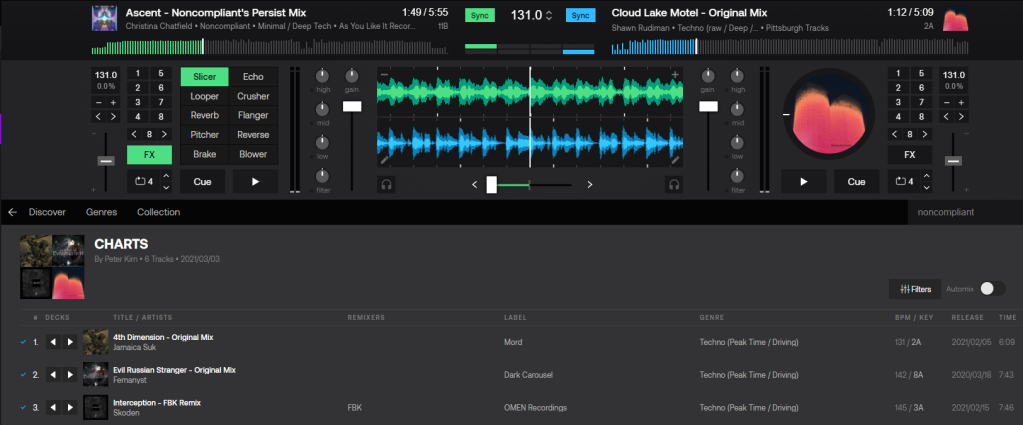
The quick summary:
Beatport DJ is a browser-based tool for Chrome and compatible browsers (Microsoft Edge, Opera).
It does everything you’d expect a two-deck DJ tool to do, but in the browser. You could actually run a DJ set off this – it even has MIDI input, controller support, and separate headphone outs, plus features like hot cues and looping. But you’ll probably use it to preview music and assemble playlists to DJ elsewhere.
It’s now released to all subscribers to Beatport’s LINK service, but will be “an entry-level stand-alone subscription tier within the LINK offering by mid-April.”
What’s in it for artists and labels – theoretically, the potential for more DJs and more streaming revenue for your music when distributed to Beatport. There’s some real potential there, as I think you’ll see, in that this removes obstacles to more people DJing with music. Since a lot of dance music gets easily lost on Spotify and Apple Music, and those tools don’t have DJ features, that’s a big deal. But what’s missing, and which I still hope will be added, is more tools for humans to share playlists and allow direct interaction with artists and labels, rather than having an entire DJ tool be dominated by Beatport charts and genre selections.
Background – about subscriptions, and different user stories
It’s worth remembering how we got here. Since the advent of digital music on computers, the digital DJ workflow has existed across some divided worlds. There’s acquiring your music – promos, stores, illicit methods. There’s cataloging your music, in a separate tool – generally Rekordbox, Serato, Traktor, and so on, though plenty of people also use something like iTunes for management. Then there’s playing your music. You might then DJ in that same tool (Rekordbox, Serato, Traktor, VirtualDJ). Or then to play on hardware decks, there’s you might use a librarian software (now almost certainly Rekordbox) to spit out your music onto a USB stick.
But notice the potential confusion between those steps, especially as syncing libraries is a major chore even for fairly experienced users.
Download stores – Bandcamp, Juno, and Beatport’s download side – all presume you buy music, then do the management of the files that gets it into your DJ software. And anyone sending out promos is generally assuming the same.
A subscription service like Beatport LINK looks more like the DJ equivalent of Spotify and Apple Music – pay one fee, and manage files in the cloud. It’s referring to the subscription aspect that’s more accurate than saying “streaming,” even though the two are sometimes used interchangeably in casual everyday speech. The pricing model is really everything. Any DJ subscription worth its salt still allows you to download files locally, or else you’d be worried about the Internet connection remaining reliable at a venue. And if the pandemic era has taught us anything, it’s that the planet’s Internet infrastructure is often dodgy.
But if the tension between that subscription (to a platform) and direct payments to artists/labels is apparent, that’s relevant, too.
The presumption here is that this kind of subscription is likely to appeal to beginners, so much so that it might even reach first-time casual DJs who might otherwise just give up. That means there are several use cases for talking about what Beatport DJ is:
- A casual or beginning DJ wanting to explore
- A more experienced DJ who already uses Beatport as a source of music
- A label or independent artist who’s curious about the impact of this kind of tool on their distribution channels
Obviously, category #3 may well be skeptical about that impact – and rightfully so, but I’ll be looking at that, as well.
Beatport DJ – what’s in the Web tool
We’ve seen some increasingly powerful in-browser tools, but Beatport DJ is by far the most sophisticated tool for DJs. Beatport could have just built some simple cross-fading and called it a day, but they kept going.
Here’s what’s in there:
- Browsing the full Beatport catalog
- Support for your existing Beatport collection
- Playlist support
- Cover art support (which looks rather nice, as you’ll see)
- Cueing (with separate headphone routing, though I didn’t get to test this yet)
- Mixing
- Automatic sync
- Manual sync (switch off sync and use the separate pitch faders)
- Separate pitch and meter controls
- Independent level controls with gain
- Metering
- Looping (with different loop modes)
- Hot cues
- FX (Slicer, Echo, Looper, Crusher, Reverb, Flanger, Pitcher, Reverse, Brake, Blower)
- EQ
- Lowpass/highpass filter
- MIDI support for external DJ controllers (also need to test this)
There’s also an Automix option which will just start playing through music as you browse, with fairly robotic mixing (but enough to let it run in the background if you want to use this almost like radio).
If you have a Beatport LINK account at any tier, this is live for you now – it’s a private beta, but you’re in it. Everyone else, I’ll try to give you a taste.
Here’s a tour (click to embiggen any image):
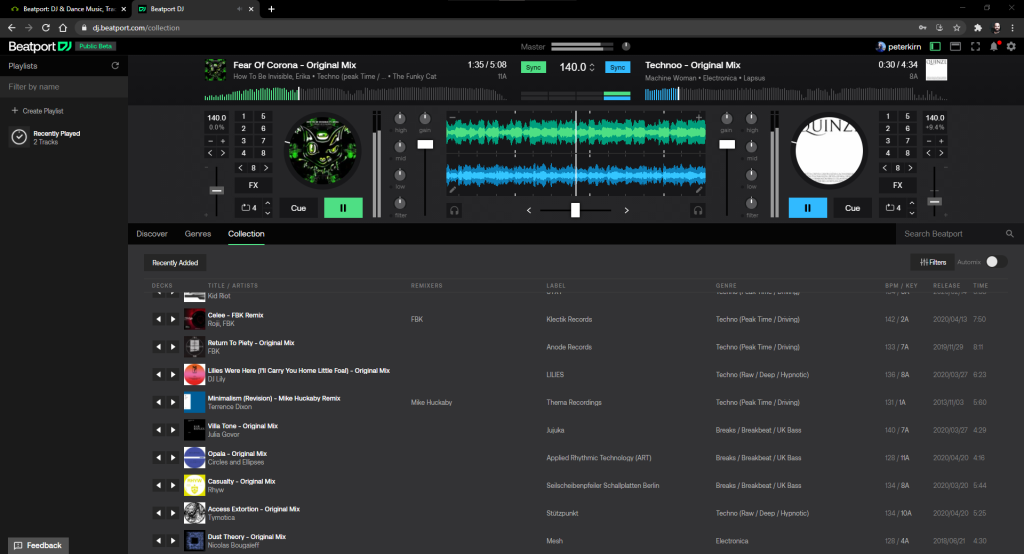
The main window really could be mistaken for an entry-level DJ tool – everything is there. Discover and Genres give you the usual Beatport-curated music, if you’re into that sort of thing. Collection gives you access to music you’ve added to your LINK subscription – or here, stuff I actually bought and downloaded.
Sync works really well, and since the metadata is already embedded in the music, there’s no separate analysis to do. And you can still turn it off, even from this Web interface. Beatmatching with a mouse is a bit tough, but it does of course allow you to hear the original pitch/bpm.)
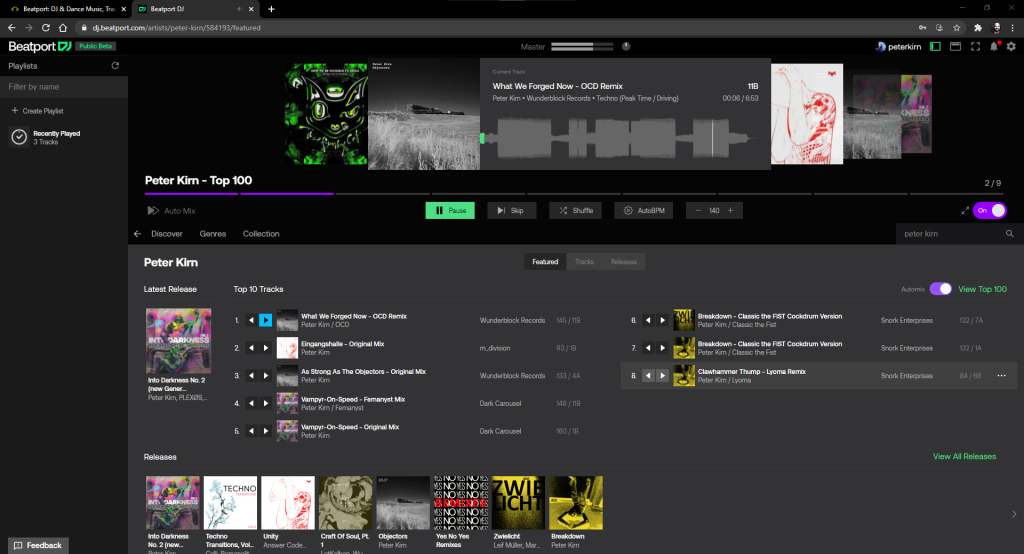
So yeah, remember when we used to talk about “Googling ourselves”? Of course, I did what you’d probably do if any of your music is on Beatport – I did a quick search for myself. If you hit Automix, whatever is displayed in the bottom pane will automatically get mixed together.
As you navigate music, you can queue up tracks to the left or right deck.
One feature that is missing, but that Beatport tells me is planned – there’s no direct “buy” link in the software. For those of us who still want downloads, or who want people to buy downloads of our music, that’s a big omission, so it’s one I’ll be looking for them to add. You can link to the existing Beatport page, though, and buy there.
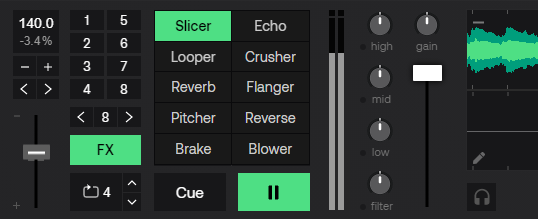
Each deck supports extensive controls. The FX inserts even have tiny little KAOSS Pad-style effects modulation for two parameters each.
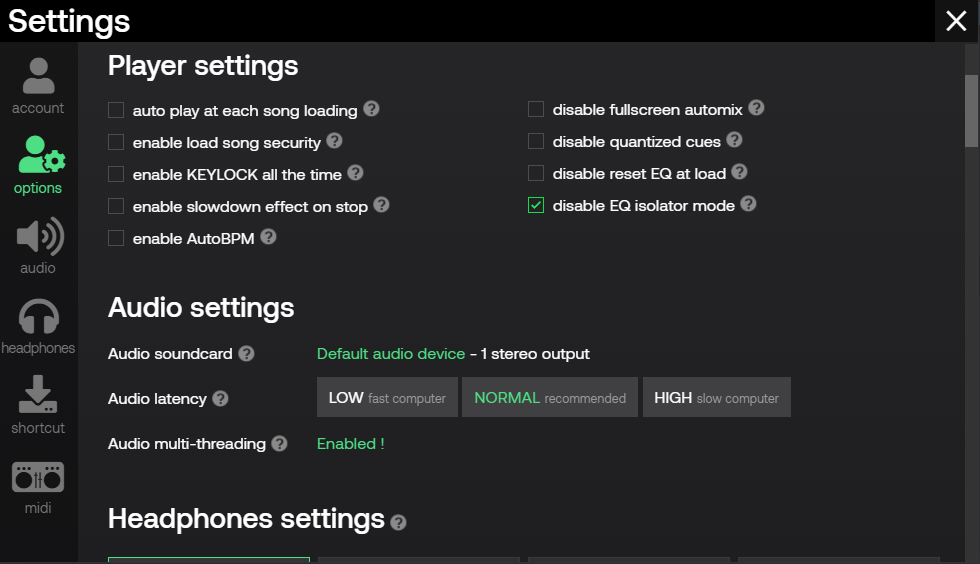
You’ll find tons of other options in Settings (the cog on the upper right hand corner), including performance options.
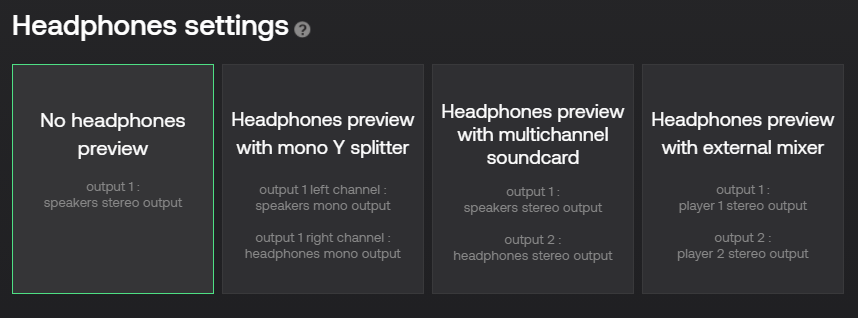
And yeah, you could actually route this to headphones.
This is a big deal in particular for Google Chromebooks, as this is the most extensive in-browser DJ option available. And as those are big in some education circumstances, that isn’t a non-issue.
It might also be a friendly option for Linux users, since it runs there, too – remember, with full audio and MIDI support.
Playlists, and what’s missing for independent humans
There is an area of Beatport DJ that seems weirdly disconnected, and that I hope gets addressed in the beta.
Hey, did you notice the last 12 months? I sure did. Apart from performances going dark and hugs becoming a thing of the past, there has been a steady drumbeat about what independent music makers need – and that is the ability to directly share their work and for their fans to directly support it.
This is not just about downloads versus streaming, or even individuals versus platforms. Tons of DJs have turned to tools like Twitch to stream directly to fans. That’s streaming, and it’s even an Amazon-owned platform.
But a year of artists turning into Bandcamp advocates, even in dance music, ought to send a message industry-wide. Artists care about ownership models and direct support. And many want to support each other, now more than ever.
The issue I have with Beatport DJ is, it has the potential to do these things but then … well, doesn’t.
The missing “buy” link is important not as just a legacy handout to some aging DJs who still believe in downloads and USB sticks. It’s also a gesture of direct support to the label and artist putting out the music. Maybe it’ll take a new form in a subscription model but – it’s not there yet.
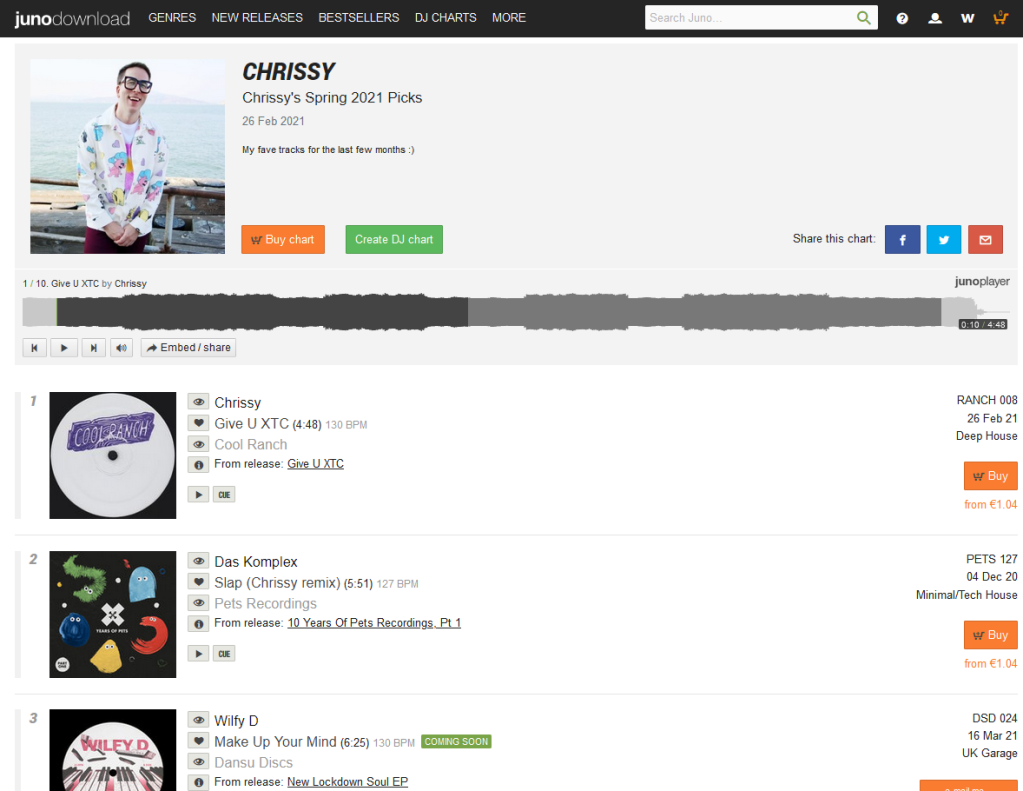
Beatport acknowledged in a demo to me that some of their users still want to buy music, but even though they said that’s a large group – somewhere just shy of a third – they also said they want to transition those users to subscriptions. That seems to ignore DJs for whom ownership models are a core value and practical reality. But even in the context of streaming and subscription models, it means relying on largely invisible streaming royalties, which also flies in the face of direct gestures of support seen now on platforms like Twitch and Patreon.
Those are thorny topics, to be sure. But Beatport left out features in this beta that exist in their current tool. Yes, it’s a beta, but that means it’s worth observing. Let me be the Ghost of Christmas Yet To Come, Beatport, and strongly urge you to reconsider.
For example, they’ve nuked the feature that is the whole reason I even log into Beatport – and I’m sure I’m not alone. “My Beatport” gives you a feed of new releases based on artists and labels you follow or purchased in the past. It looks like this:
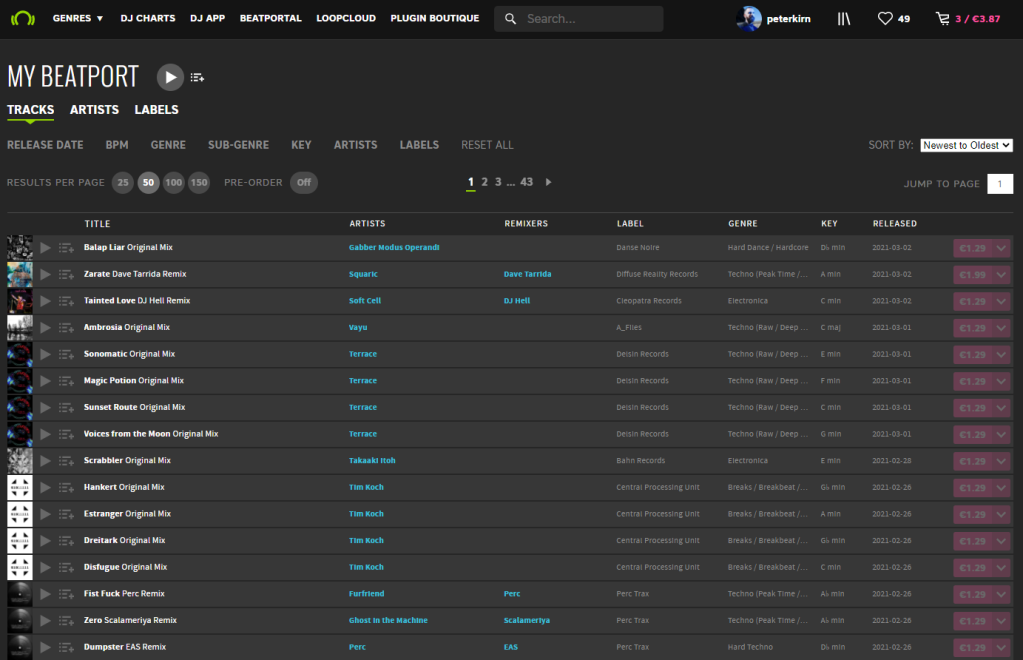
I’ll sometimes wind up buying a hundred bucks worth of music this way. I’ve written editorial features on it, assembled charts with music I spotted here. And it arguably makes even more sense in Beatport DJ, because then you’d have the ability to audition and mix those new releases.
But – it’s not there. Not yet.
One feature that does work really terrifically well is the playlist editor in Beatport DJ. Here I’ve assembled a chart:

There is a disclosure menu in the Playlists pane that lets you view the same playlist on Beatport. But for now you don’t have the ability to share easily with others.
There’s also real potential for this far-superior playlist editor to replace the somewhat clunky “charts” feature that’s now in Beatport. We need these kinds of charts badly now partly because they’re disappearing elsewhere. Resident Advisor quietly killed its own charts feature in January.
That leaves tools like buymusicclub (for Bandcamp) or even currents.fm, but a lot of dance labels rely heavily on Beatport and charts remain important. Given these kinds of tools, they might embrace Beatport DJ and even be a part of attracting first-time DJs. Without them, they would understandably better invest efforts elsewhere. (And Beatport does still have competitors.)
Look, let’s be clear about one thing – this app is fun, no question. It’s a fantastic way to navigate music. And whatever your feelings about Beatport or LINK, I have no doubt that it’d be great to get to navigate stores like this. I’d pay extra to stream like this as a preview, and pay again to buy downloads, even.
But the whole potential of the browser should be sharing. Instead, Beatport DJ is an insular experience – and the recommendations you see are all the old-fashioned kind of charts and recommended genre picks.
There are some clear places to start – more playlist sharing (which at least I am told is planned), in-browser buying (so users can themselves choose whether ownership matters or not), and user-curated follows (as with My Beatport), and crucially the ability to share outside Beatport. The company already has an innovative tool for Twitch, so they’re on their way if they so choose.
From Twitch streamers to Bandcamp Friday, human-to-human sharing and support is the common theme of all the musical practices that have gotten us through a year of terrible isolation.
Beatport has built an amazing player in a browser. Now they just need to add the Internet of humans back in – so it isn’t only an island.
We’ll be watching this evolve and where producers and labels will most benefit.